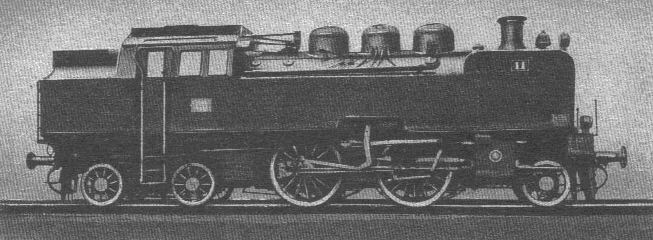2-4-4T on:
[Wikipedia]
[Google]
[Amazon]

 Under the
Under the
 Under the
Under the Whyte notation
The Whyte notation is a classification method for steam locomotives, and some internal combustion locomotives and electric locomotives, by wheel arrangement. It was devised by Frederick Methvan Whyte, and came into use in the early twenti ...
for the classification of steam locomotives by wheel arrangement, 2-4-4 is a steam locomotive
A steam locomotive is a locomotive that provides the force to move itself and other vehicles by means of the expansion of steam. It is fuelled by burning combustible material (usually coal, Fuel oil, oil or, rarely, Wood fuel, wood) to heat ...
with two unpowered leading wheel
The leading wheel or leading axle or pilot wheel of a steam locomotive is an unpowered wheel or axle located in front of the driving wheels. The axle or axles of the leading wheels are normally located on a leading truck. Leading wheels are used ...
s followed by four powered driving wheel
On a steam locomotive, a driving wheel is a powered wheel which is driven by the locomotive's pistons (or turbine, in the case of a steam turbine locomotive). On a conventional, non-articulated locomotive, the driving wheels are all coupled t ...
s and four unpowered trailing wheel
On a steam locomotive, a trailing wheel or trailing axle is generally an unpowered wheel or axle (Wheelset (rail transport), wheelset) located behind the driving wheels. The axle of the trailing wheels is usually located in a trailing Bogie, t ...
s. This configuration was only used for tank locomotive
A tank locomotive is a steam locomotive which carries its water in one or more on-board water tanks, instead of a more traditional tender (rail), tender. Most tank engines also have Fuel bunker, bunkers (or fuel tanks) to hold fuel; in a #Tender ...
s.Equivalent classifications
Other equivalent classifications are: *UIC classification
The UIC classification of locomotive axle arrangements, sometimes known as the German classification''The Railway Data File''. Leicester: Silverdale, 2000. p. 52. . or German system,Kalla-Bishop P.M. & Greggio, Luciano, ''Steam Locomotives'', Cr ...
: 1B2 (also known as German classification and Italian classification)
*French classification Under the French classification system for locomotive wheel arrangements, the system is slightly different for steam and electric/diesel vehicles.
Steam
The French system counts axles, rather than wheels. As with Whyte notation, a conventional r ...
: 122
* Turkish classification: 25
* Swiss classification: 2/5
The equivalent UIC classification
The UIC classification of locomotive axle arrangements, sometimes known as the German classification''The Railway Data File''. Leicester: Silverdale, 2000. p. 52. . or German system,Kalla-Bishop P.M. & Greggio, Luciano, ''Steam Locomotives'', Cr ...
is 1′B2′ t (or (1′B)2′ t for a Mason Bogie).
Examples
This unusual wheel arrangement does not appear to have been used on the mainline railways in the UK. It was however one of the configurations used on theMason Bogie
Mason Bogie locomotives (also known as Mason Fairlie locomotives) are a type of articulated tank locomotive suited for sharp curves and uneven track, once commonly used on narrow-gauge railways in the United States. The design is a development of ...
articulated locomotive
An articulated locomotive is a steam locomotive (rarely, an electric locomotive) with one or more engine units that can move independently of the main frame. Articulation allows the operation of locomotives that would otherwise be too large to ...
s, in the USA during the 1870s and 1880s. Five examples were constructed at the Mason Machine Works
The Mason Machine Works was a machinery manufacturing company located in Taunton, Massachusetts, between 1845 and 1944. The company became famous for an early invention by its creator, William Mason, the self-acting mule, first patented in 1840 ...
for the narrow gauge
A narrow-gauge railway (narrow-gauge railroad in the US) is a railway with a track gauge (distance between the rails) narrower than . Most narrow-gauge railways are between and .
Since narrow-gauge railways are usually built with Minimum railw ...
Boston, Revere Beach and Lynn Railroad 1883–1887. The railway subsequently received twenty-one further examples between 1900 and 1914, constructed by the Taunton Locomotive Manufacturing Company, Manchester Locomotive Works, and ALCO
The American Locomotive Company (often shortened to ALCO, ALCo or Alco) was an American manufacturer that operated from 1901 to 1969, initially specializing in the production of locomotives but later diversifying and fabricating at various time ...
. Developmentally, there are two logical ways of reaching this wheel formula: to add a forward axle to a Forney locomotive to improve its ability to negotiate curves, or to add a second trailing axle to a Columbia design, notably in a 2-4-4(T) configuration to expand its coal capacity.
Four 2-4-4T passenger locomotives were built by the Czechoslovak Škoda for Lithuania in 1932 and marked as Tk class. They were seized by the USSR in 1940, then by the Germans. One was used after World War II in Poland as OKf100-1 until 1950.Paweł Terczyński, ''Atlas parowozów'', Poznań, 2003, , p. 94
Other tank locomotives with 2-4-4T arrangement:
* Bavarian D XII
*French T5 6601 - 6637 of AL railway
References
4,2-4-4T 4,2-4-4 {{Steam-loco-stub